Sabich, Street Food of Israel
Sabich is a sandwich of fried eggplant and hard-boiled egg, stuffed into a pita with salad and sauce, originating in the Tel Aviv district of Israel. The street food is said to have originated with Iraqi Jews, freshly migrated to Israel in the 40s and 50s, and their practice of eating eggs, potatoes, and eggplant for breakfast on the Sabbath, slowly heated overnight on top of their T’beet pot.
In the Jewish tradition, Saturdays are the sabbath, when work of any kind is forbidden. Even as simple an act as lighting a fire cannot be done from sundown on Friday to sundown on Saturday. So traditional meals for the sabbath are prepared on Friday before sundown and cooked slowly over very low heat for 14 or 16 hours before being eaten at midday on Saturday. These meals are called Cholent, or hamin. T’beet is an Iraqi version of this meal, involving a whole chicken stuffed with rice, giblets, and aromatic spices. Often eggs or other foods are set on top of the stew or atop the pot and allowed to slow cook as well, to be eaten for breakfast.
In any case the sandwich began in the city of Ramat Gan, in Tel Aviv, served at scattered street stalls run by Iraqi migrants, sold to truck drivers, factory workers, and other laborers. The name is alternately said to come from the Arabic word for “morning” or “dawn,” or the first name of a man ran one of the first stands selling the sandwich, or even from the letters SBH standing for Salat (salad), Beitzah (egg), Hazilim (eggplant). While the last is silly, the first is plausible, but the middle explanation is the most pleasing to me. I like a sandwich with a story.
“Our first stand was in Bar-Ilan Park at 60 Uziel Street, Ramat Gan,” she says, a wistful look in her eyes as she thinks of her late husband. He was born in Baghdad in 1938, made aliya in the early 1950s and died in 2012. “Sabich was working in an iron molding factory when he saw a small kiosk an elderly couple had put up for sale for key money. The kiosk was opposite the last stop of the Number 63 bus, and drivers and ticket-sellers used to buy bourekas and wafers and drinks. The drivers told Sabich they wanted something more substantial to eat, and he asked me to give him the leftover brown eggs from Shabbat. Like every Iraqi family, we ate a traditional breakfast of brown eggs that were cooked on top of the tebit – chamin – together with fried eggplant and salads. We ate the same thing back in Iraq.
“We started with 10 eggs and a tray of fried eggplant,” says Halabi. “And the drivers, who were mostly Ashkenazim, loved it. The business started to take off. Sabich brought a petiliya(kerosene burner) and started cooking the eggs in pickle tins. I kept frying the eggplant at home. He would fill the pita with amba, a brown egg, fried eggplant and a simple vegetable salad of tomatoes and cucumbers.
“It’s funny. They used to say, ‘Sabich, give me one, and now they say, ‘Give me a sabich.’”
Sabich in Chicago
While there are in fact many eateries in Chicago serving various types of Israeli street food (Benjyehuda comes to mind), few of them serve Sabich. One of those is Ēma, a “Mediterranean restaurant showcasing Chef CJ Jacobson’s lighter California style of cooking.” Mindy and I stopped by for lunch recently to check out their version of the Sabich as our initial foray into the sandwich.
Ēma’s Sabich is served in a grilled pita with a simple and lightly citrusy side salad. Inside was a salad of tomatoes and cucumbers, a halved boiled egg, a plank of pickled turnip, and presumably some eggplant, though after splitting the sandwich in half to share with Mindy I’m not sure my half contained any.
Regardless, the sandwich was delightful, full of bright Mediterranean flavors, light but filling enough for a lunch. Mindy ordered a lamb ragu served over a bed of hummus with flatbread, so between the two plates we felt like we had enough for two, though as a “small plates” type place, they do encourage you to order more. We enjoyed it though and were intrigued enough by several other menu items that we do plan to return.
The next day, we visited a restaurant that we’ve walked by several times on our way to a show at Steppenwolf Theater, Dawali Mediterranean Grill, to try their take on the sandwich.

Fattoush salad from Dawali 
Chicken shish kebab from Dawali 
Sabich from Dawali
Mindy ordered Dawali’s Fattoush salad, which came with some very interesting looking pita croutons but was otherwise unremarkable. Our 11yo son Ian ordered chicken shish kebab, which was the best thing on our table that day, the chicken perfectly grilled and served on a bed of tasty yellow rice along with a ramekin of garlicky Toum. My sabich, also served with a side of Toum, was less successful. The salad, rather than a composed, dressed mixture of finely diced tomatoes and cucumbers, appeared to be a simple undressed side salad of lettuce with tomato and cucumber, stuffed into the pita. I opened up the sandwich and peeled it back to locate the eggplant.
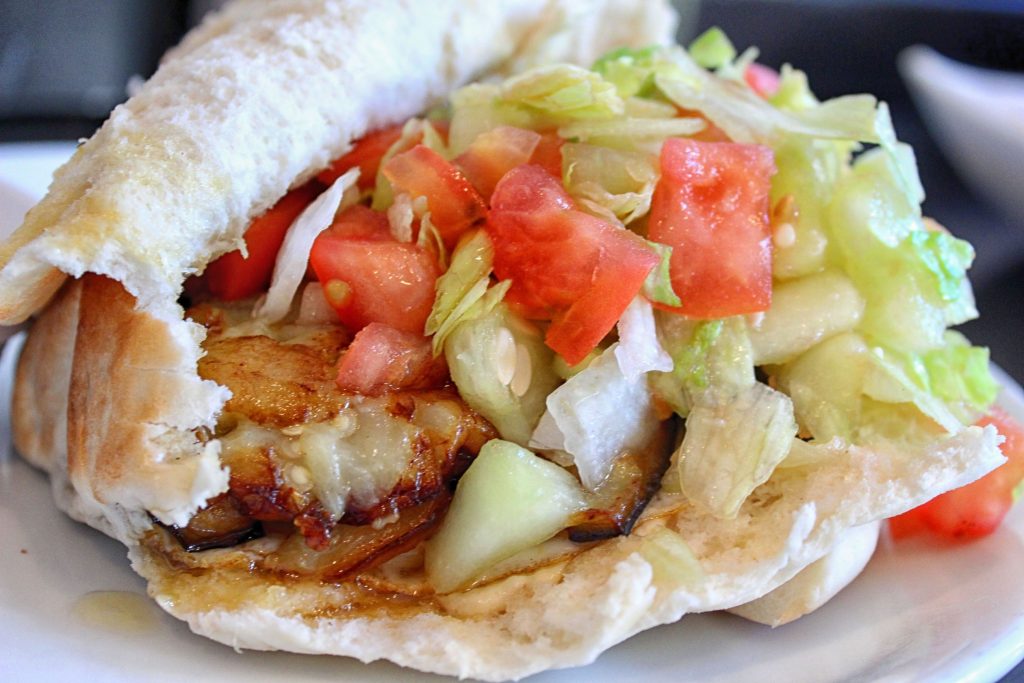
Merely by virtue of existing, the eggplant in this sandwich was superior to what I’d experienced at Ēma, and in fact it was quite good, but everything else was crude by comparison. The sandwich contained a fried egg, which was an interesting contrast to the halved boiled egg at Ēma, and provided a little egg for every bite, but was not enough to save the sandwich.
My Own Sabich–First Attempt
Based on this recipe from a site called My Jewish Learning, I sliced an unpeeled eggplant into 1/2″ thick rounds which I salted and allowed to drain for about 45 minutes before pressing them between paper towels to dry them and frying them in 1″ of Canola oil for about 5 minutes on the first side and 3 minutes on the second.
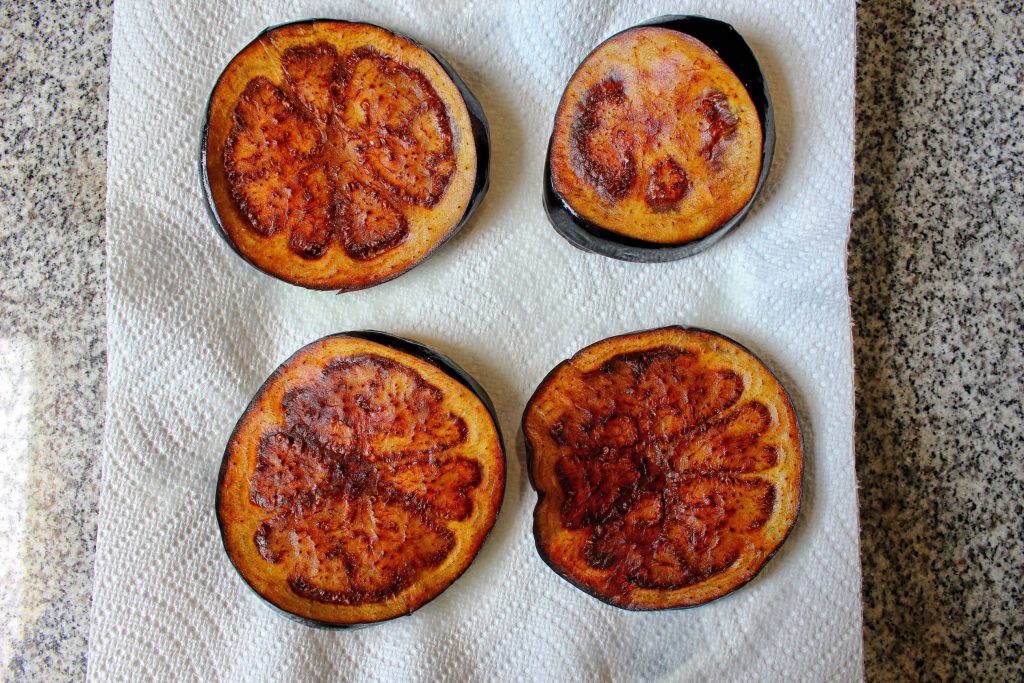
For my salad, I diced a cucumber, a tomato, and a little red onion finely, combining them with some lemon juice, olive oil, salt, parsley, and mint. I made the hummus and tahini sauce using the same rough process I described in my post on Falafels a while back, and like I did then, I bought the pitas at Alwatan Bakery, a favorite of mine in Bridgeview, Illinois. While in Bridgeview, I also picked up a jar of something called Anba, which I took to be Amba, the pickled mango sauce described in so many articles about Sabich

Garlic tahini sauce 
Pita from Alwatan 
Homemade hummus 
Israeli salad
Normally one would simply slice open one end of the pita and stuff the ingredients in, but I split this one in half entirely to get a better view of the sandwich interior. It made for sloppy eating afterwards.
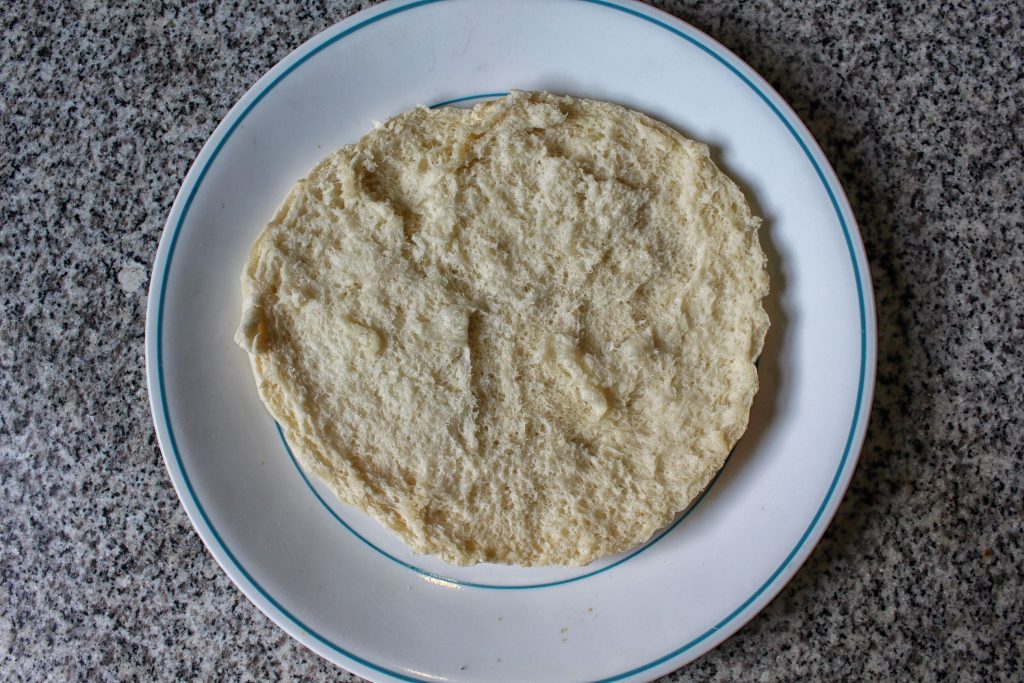
Starting with the plain split pita, I spread the bottom half with hummus.
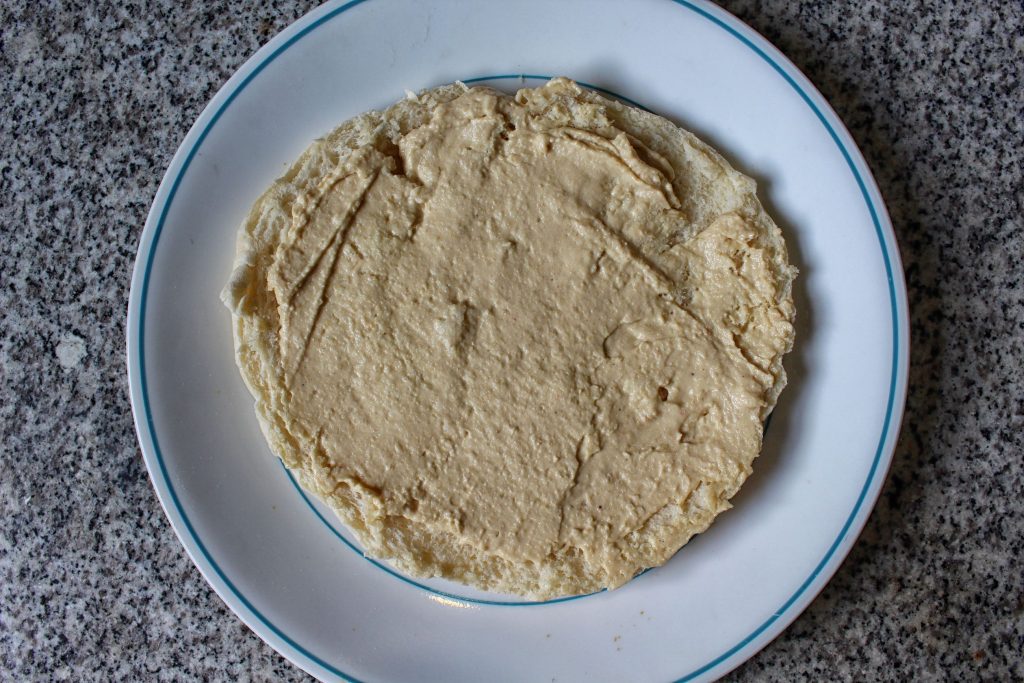
Then I added the fried eggplant.
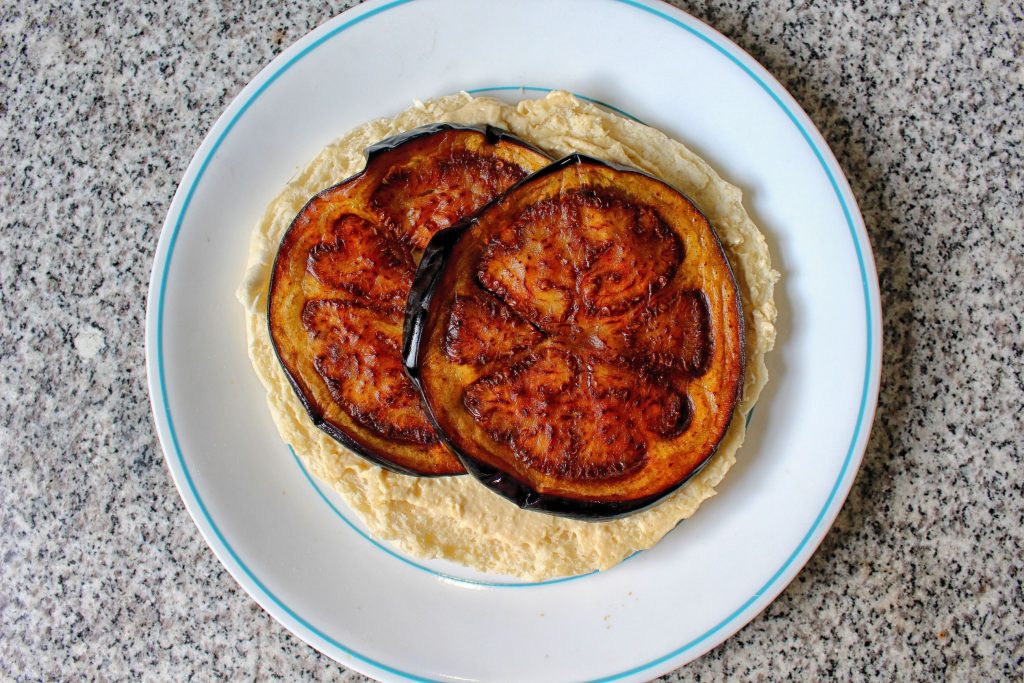
I spread the tahini sauce on the eggplant then put my salad on top of that.
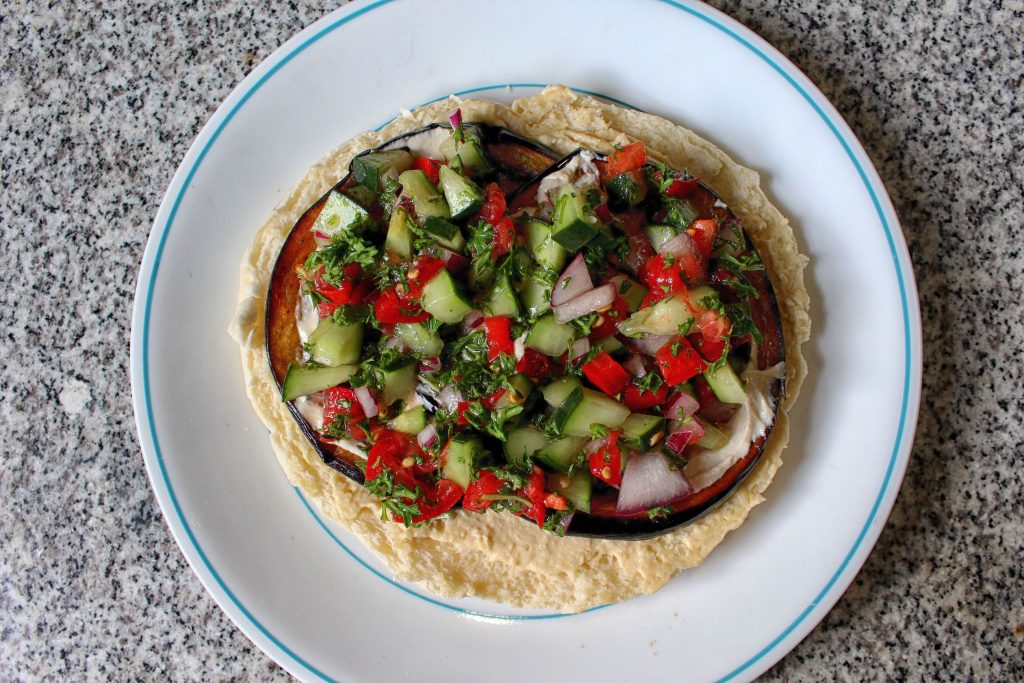
Finally, I added some sliced boiled egg.
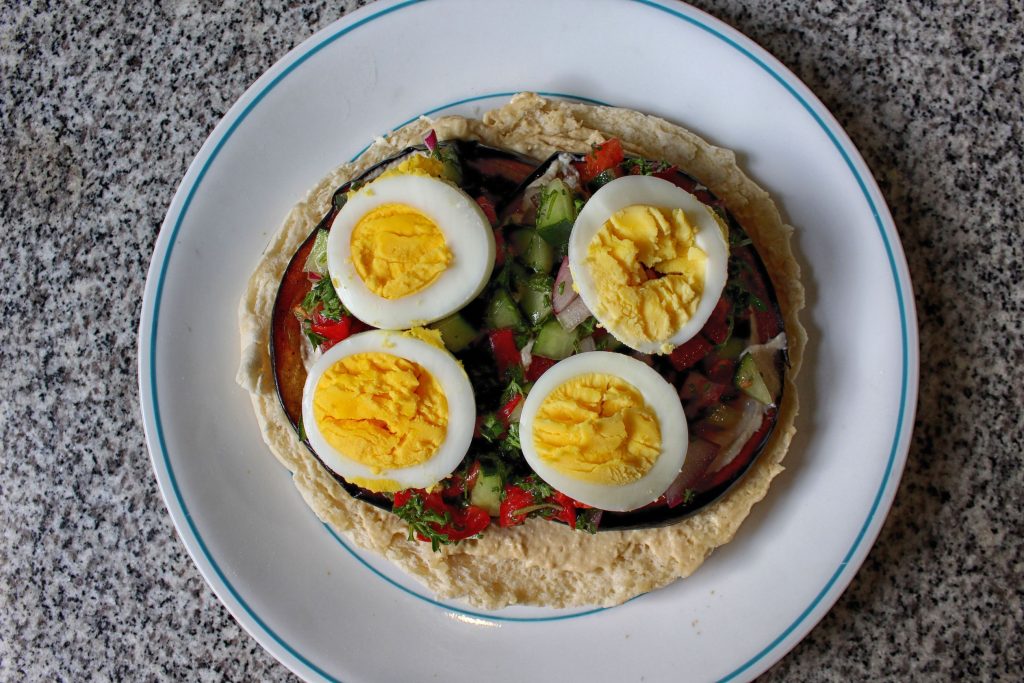
Now for the Amba, or Anba. When I read the ingredients on the jar’s label, I was surprised to find zero mention of mango. This was a pickled vegetable mixture in a turmeric-heavy yellow sauce. I used it, but it was not what I was looking for. I also added some Mediterranean style pickled cucumbers.
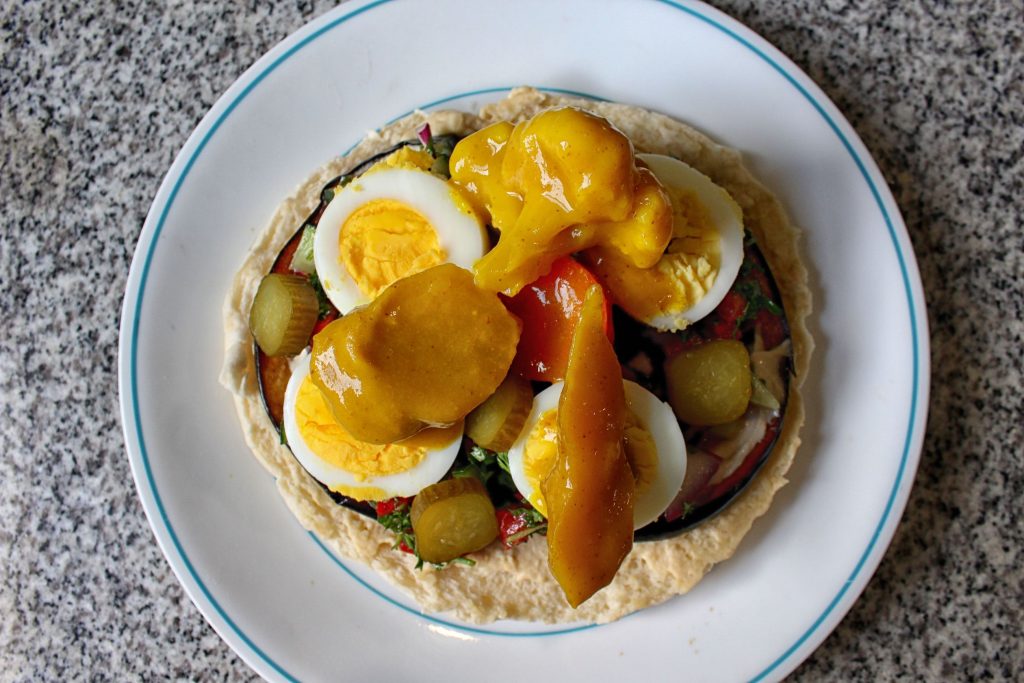
I put the other half of the pita on top and tried to arrange it the way a normal Sabich would look.
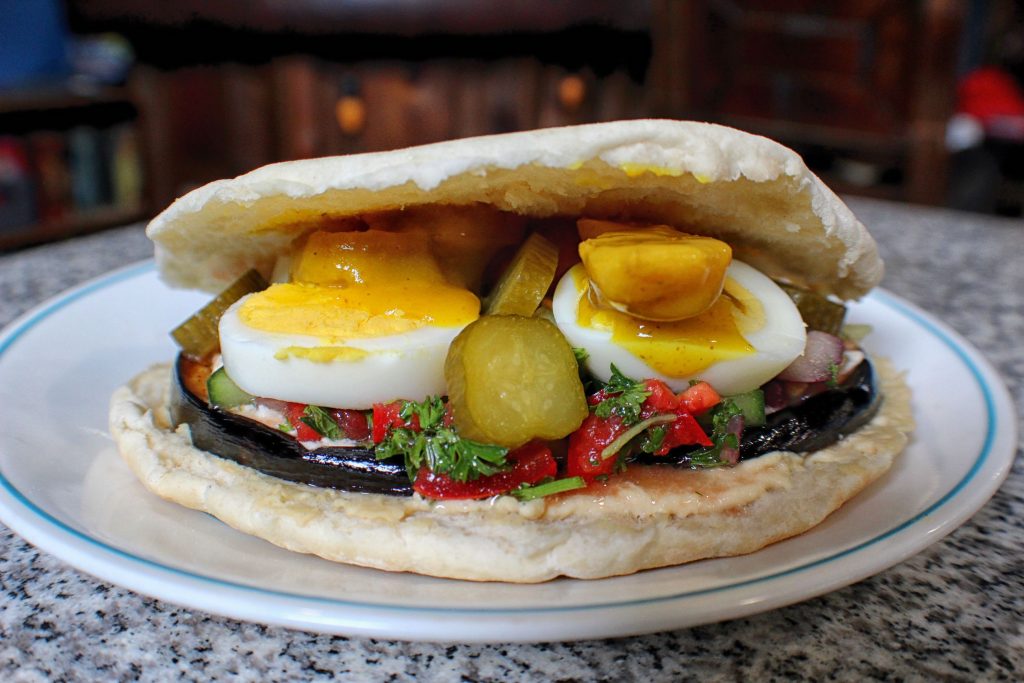
My salad, hummus, and tahini were all great. I also make a mean hard-boiled egg. The Anba was interesting but again, not really what the sandwich calls for. Salting and pressing the eggplant draws out moisture that would otherwise make the fried eggplant soggy but the eggplant skin turns into something akin to dental floss in the fryer. It was a tasty sandwich but it still seemed off, somehow.
First off, the Amba. It’s barely mentioned in the Wikipedia article on Sabich, but my other reading has told me it’s essential to a proper Sabich. I realized that local Mediterranean chain Naf Naf Grill has Amba as one of the sauces available for their falafel and shawarma sandwiches, as well as something called S’Khug, which is their version of Zhug, an herby hot sauce that is also popular as a Sabich condiment. See the following video, about 50 seconds in.
Funny thing, the Amba I got from Naf Naf tastes quite a bit like the sauce in the Anba jar I bought, minus the pickled vegetables.
Mindy did a little research and found a cookbook called “Israeli Soul” that had more information about Sabich. This book’s Sabich recipe borrows a technique from a Tel Aviv falafel stand called HaKosem–the eggplant is sliced, salted, and patted dry much the same as in my previous attempt, but then is dredged in corn starch before being pan fried in just a little oil. The result is a crisp round of fried eggplant that holds its shape fairly well, even peeled, thus avoiding the razorlike fried eggplant peels.
So I tried again, this time splitting the pita into a pocket as is proper for this type of sandwich
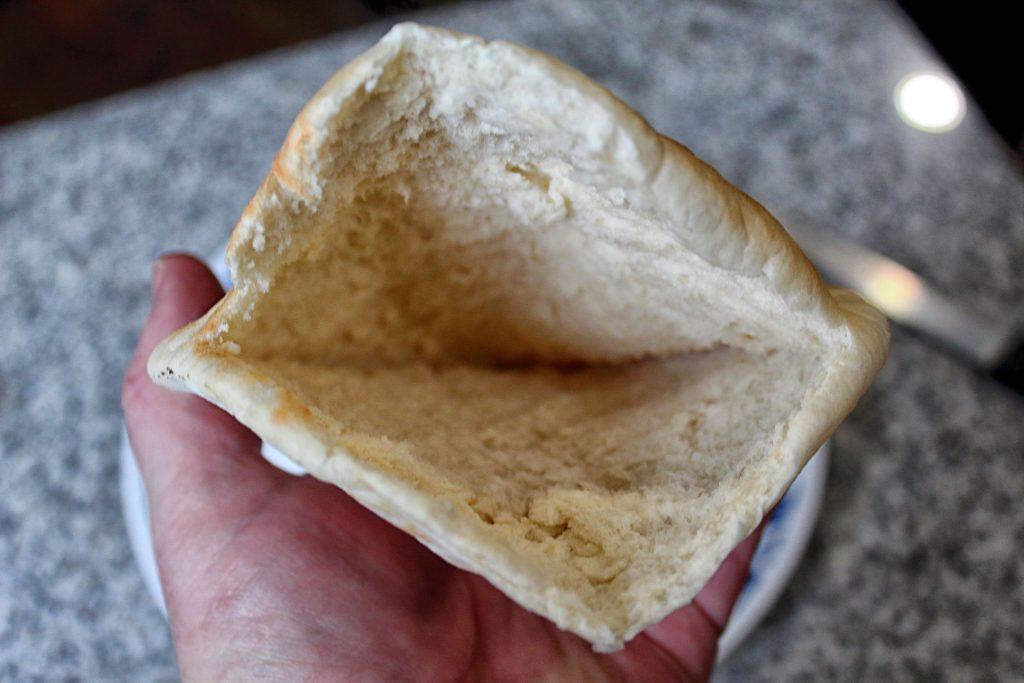
The Israeli Soul recipe puts eggplant on the outsides of the sandwich. This helps keep the eggplant crisp and also protects the bread from the various sauces that will be added.
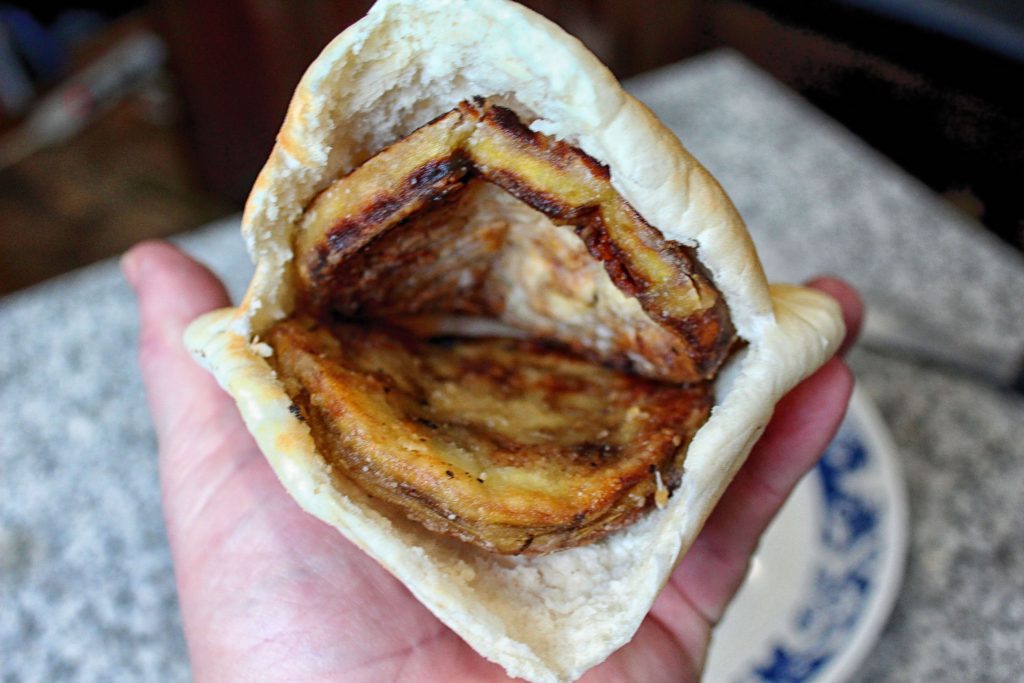
Then the hummus is spread inside the pocket of eggplant.
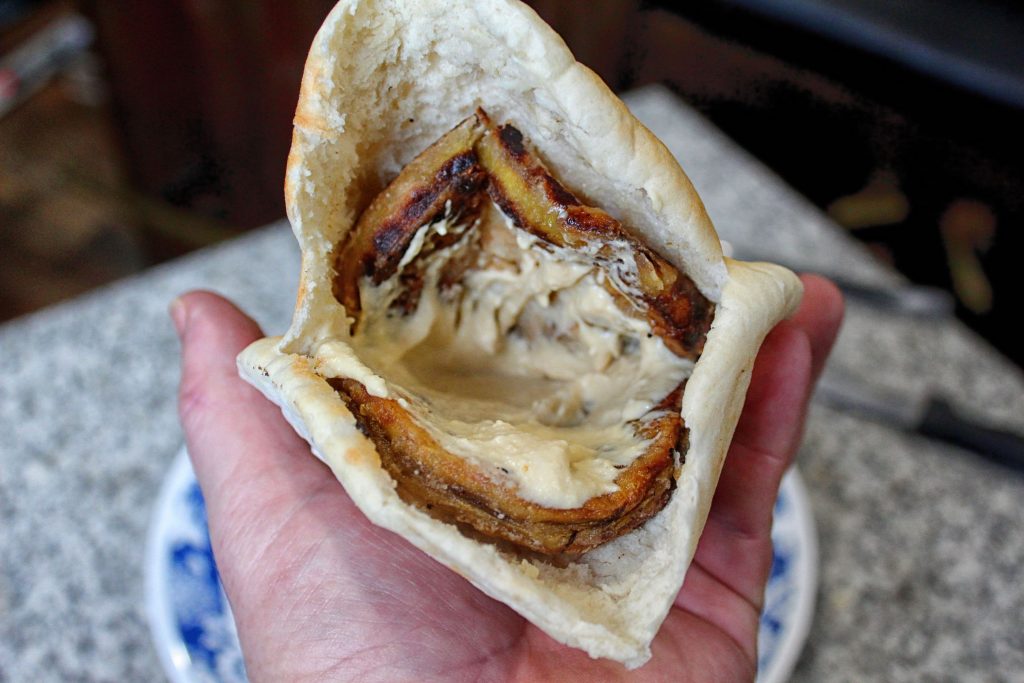
The Israeli Soul recipe calls for the eggs to be sliced, but other descriptions I’ve read and videos I’ve seen have a whole egg inserted into the sandwich and then mashed in place with a fork. This helps spread the egg throughout the sandwich equally.

The salad is added after the egg.
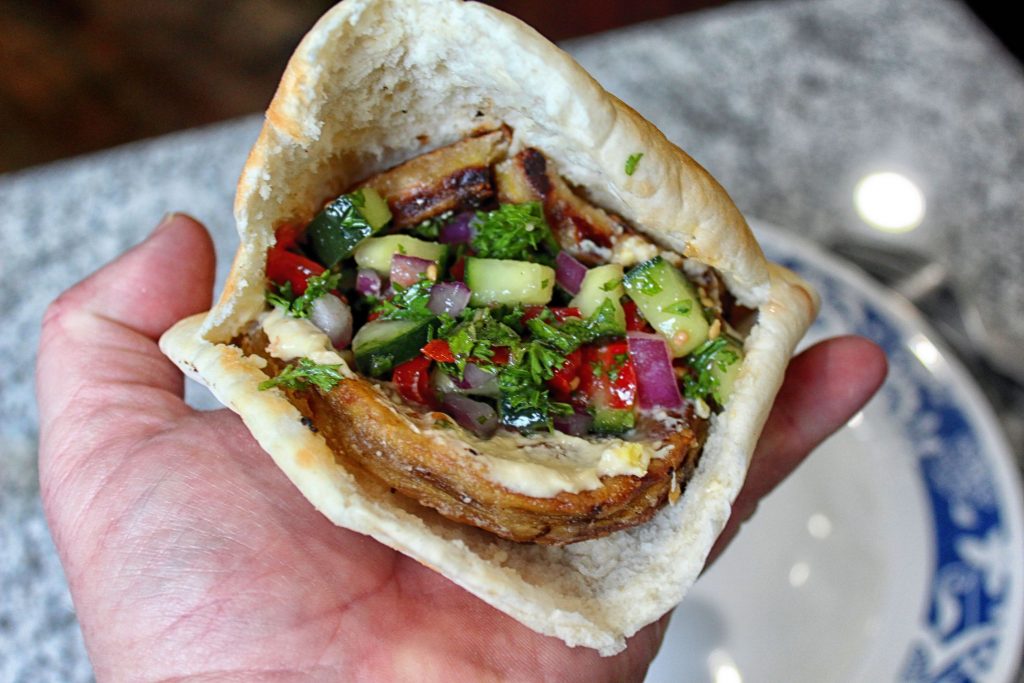
After that, the sauces are drizzled in. My previous tahini sauce was too thick for drizzling, so I made a thinner version which, along with the amba and zhug I got from Naf Naf, I had ready in plastic condiment bottles. For Mindy’s Sabich, I used tahini and amba only.
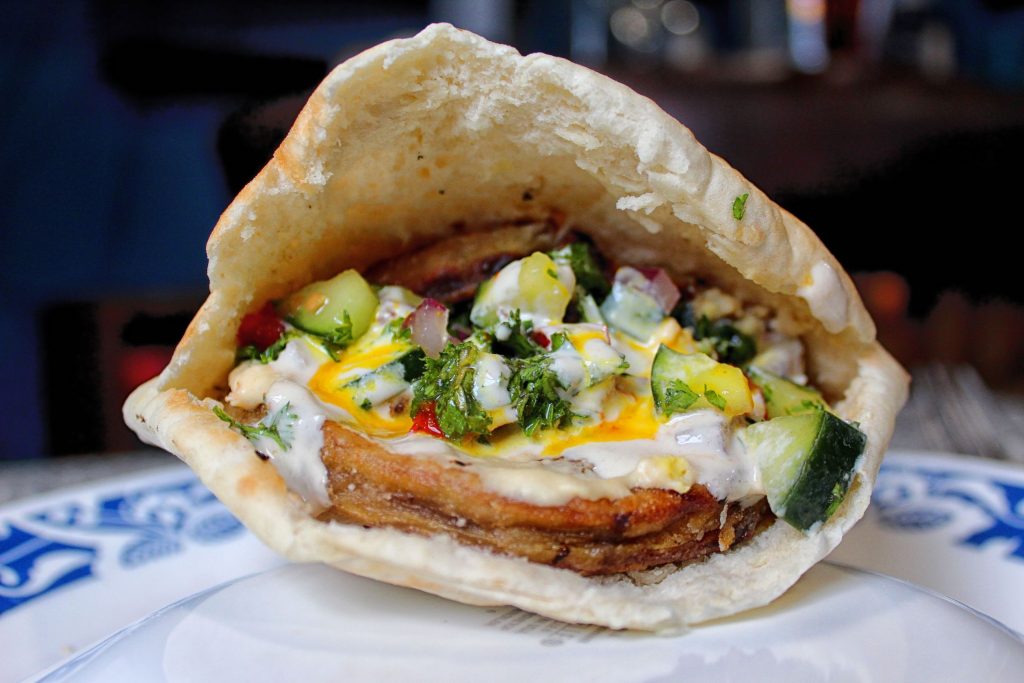
For my own, I also added plenty of zhug.
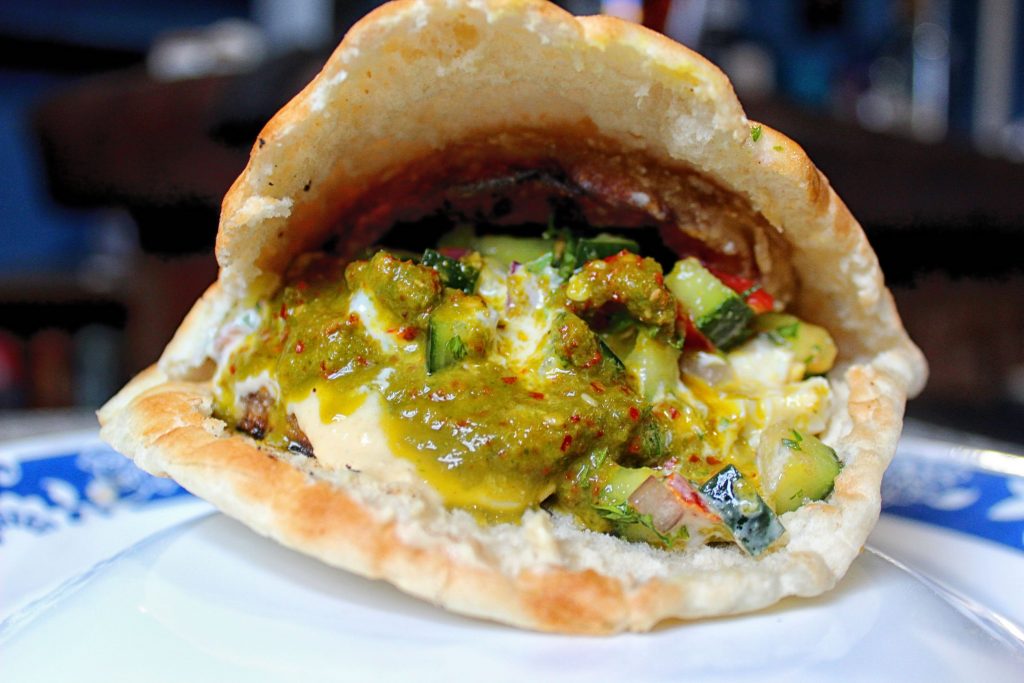
This was a far more successful sandwich. Clearly it was neater, since the fillings were contained in the pocket of the pita, but there was more to it than that. The cornstarch-fried eggplant was crisp and warm, and the outside edges retained that crispness while the inside took on that creamy eggplant texture. The mashed egg made its way into every bite along with the bright crunch of the salad. The tangy mango and fenugreek flavor of the amba and the spicy herbaciousness of the zhug did not penetrate into the deepest recesses of the sandwich but were a highlight of the first few bites.
Sabich sandwiches, like its better-known Mediterranean fellows falafel and shawarma, combines a variety of textures and flavors into a self-contained envelope of tastiness, and it seems like a natural addition to a menu where falafels and shawarma are already served. Well known in Israel, it has yet to make a big splash in the US and elsewhere. But as I found, it does exist here. Hopefully as more places catch on and start to offer it, better options will become available. For now, I’ll stick with the ones I make at home.

I like sandwiches.
I like a lot of other things too but sandwiches are pretty great


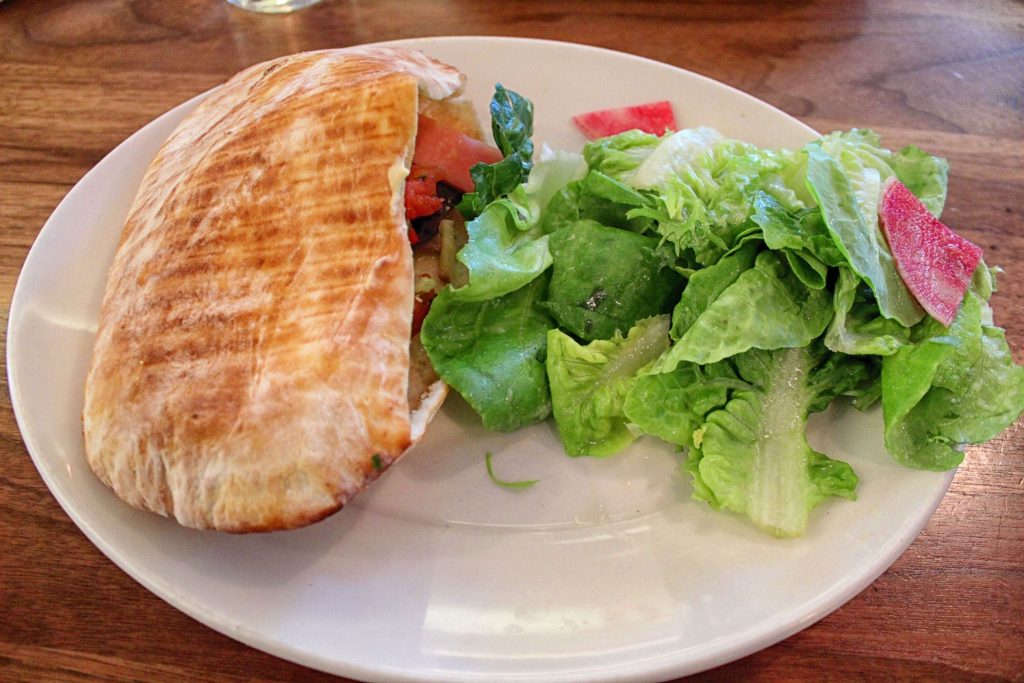
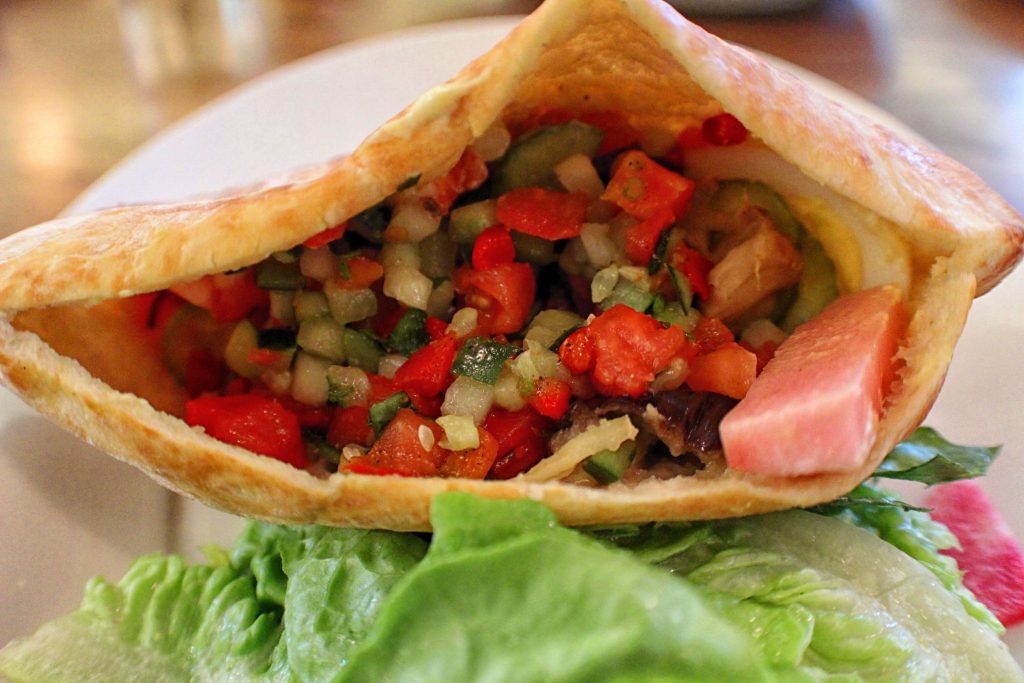
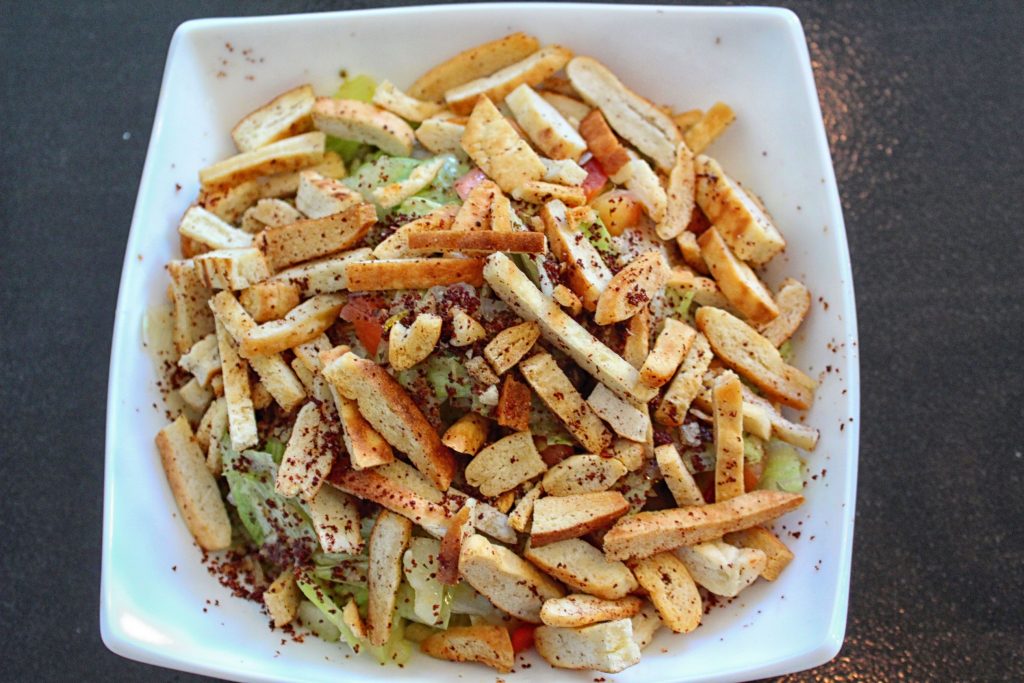

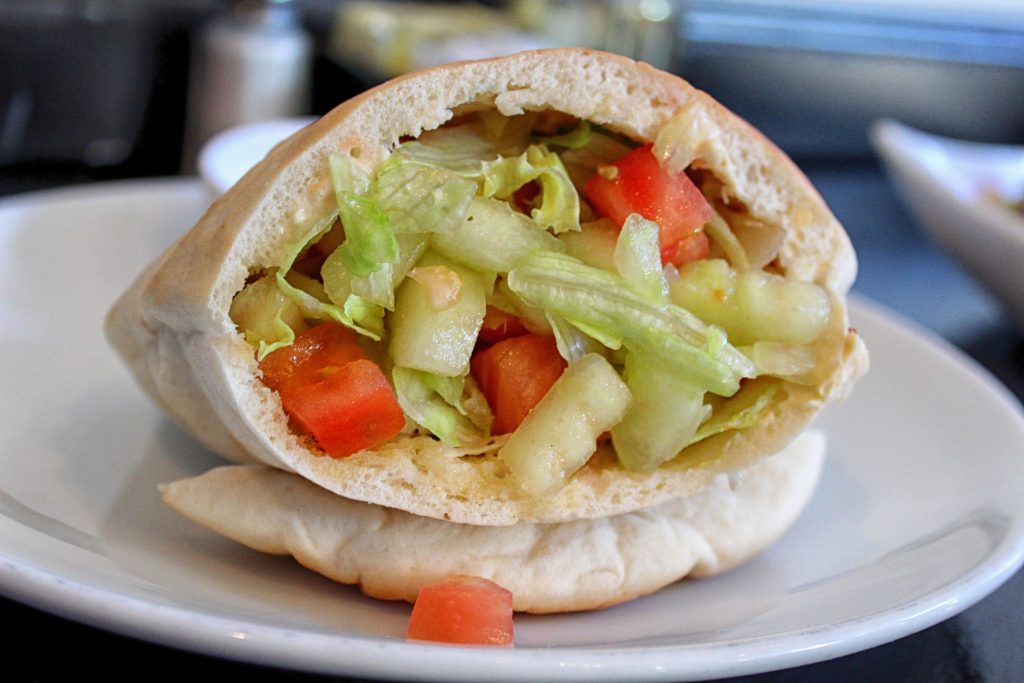
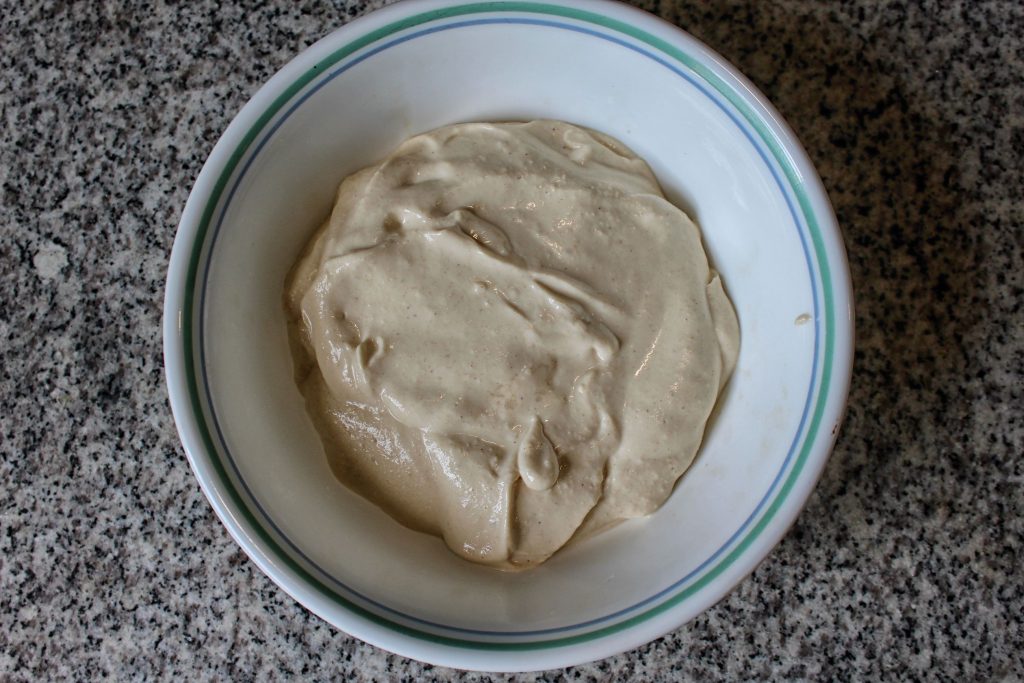
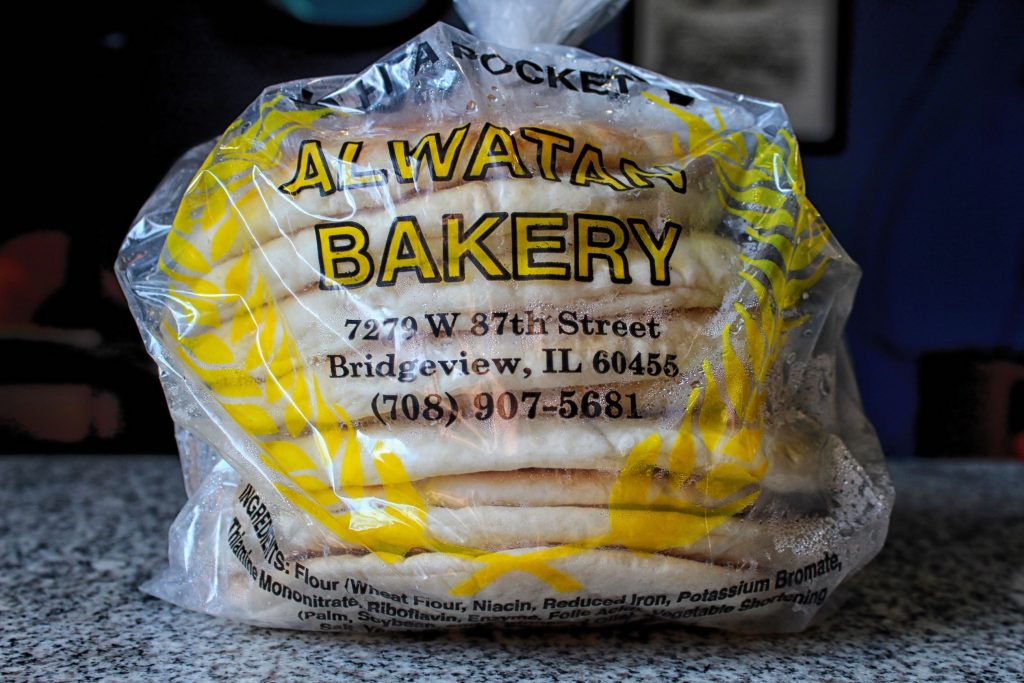
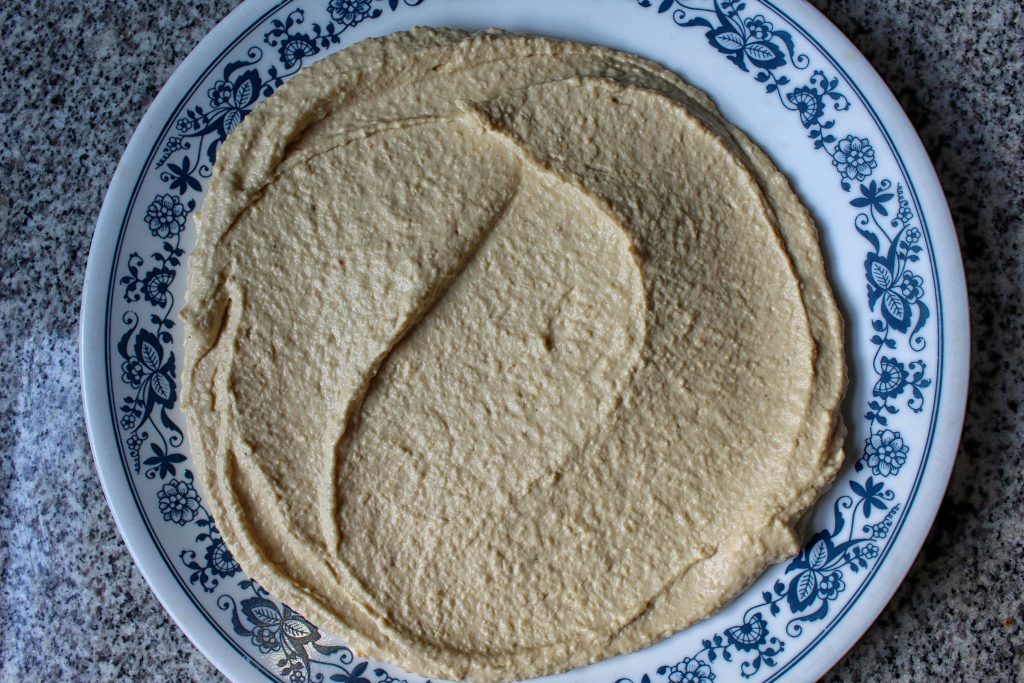
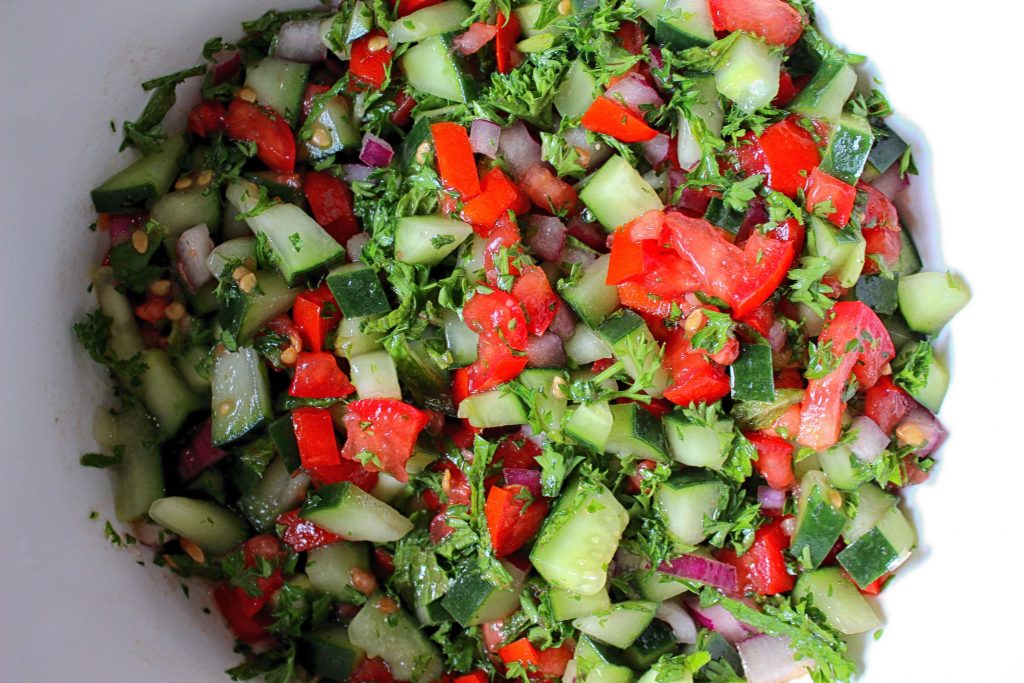
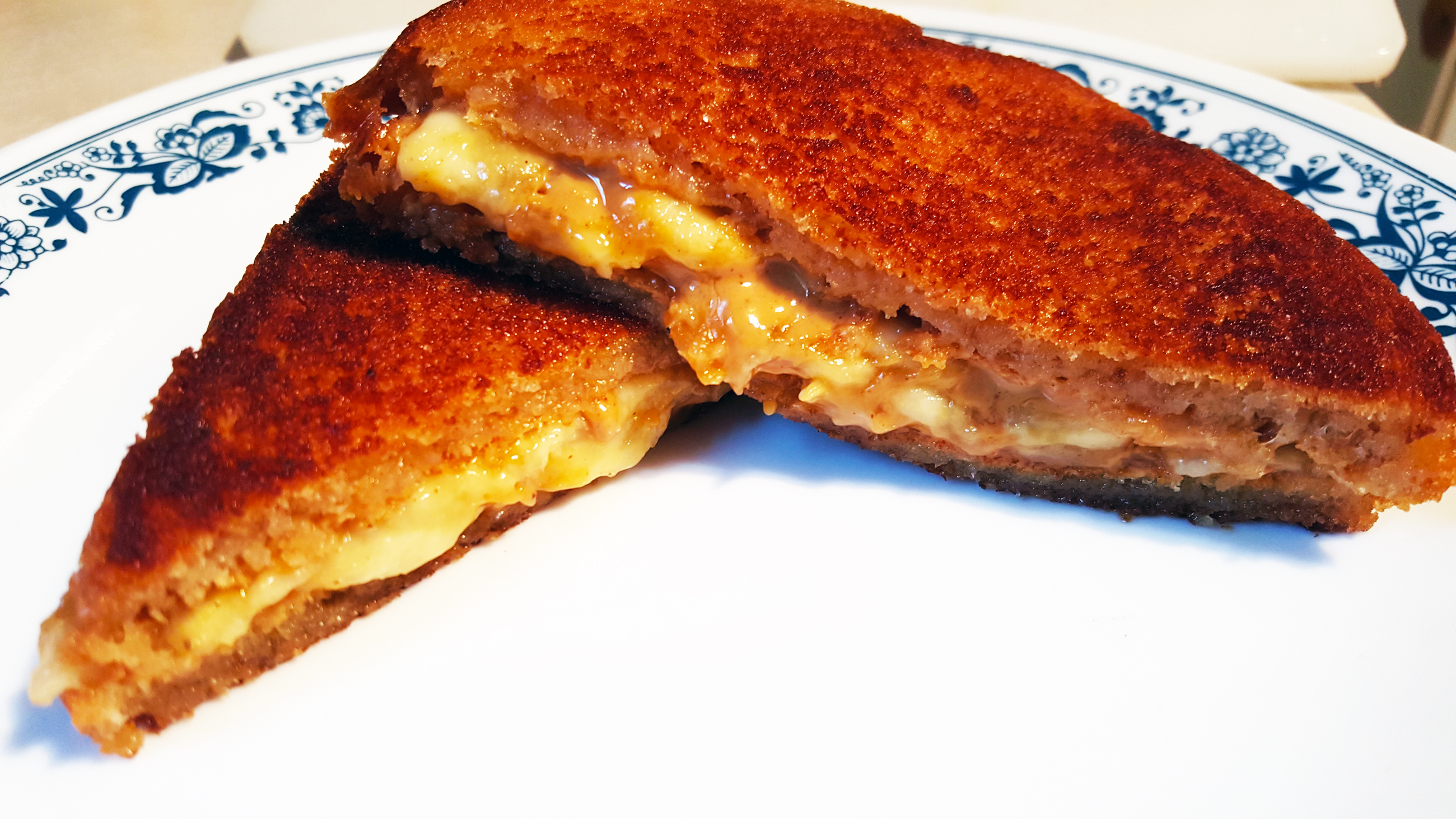








I make this a lot- love sabich! great post!
FYI, I substitute a good watered down mango chutney for the amba.